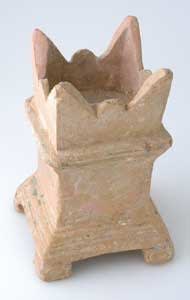Miniature Horned Incense Altar, 50 BCE - 100 CE
Terracotta
2.875 x 4.75
PF.2300
Further images
Altars with four extended horns at the top corners had a very ancient tradition in Israel, with examples of stone surviving from the Bronze Age period. Sacred law automatically protected...
Altars with four extended horns at the top corners had a very ancient tradition in Israel, with examples of stone surviving from the Bronze Age period. Sacred law automatically protected a person seeking refuge who clutched one of these horns. The book of Exodus relates how God gave Moses instructions for two kinds of altars: one for blood sacrifice, the other for the burning of incense. This clay brazier, formed in the shape of a large square altar, was probably a votive gift at a shrine or temple. The burning of aromatic incense is still evidenced by the fire marks in the top depression. Hints of its original painted green surface can still be discerned. Although relatively simply formed, this votive altar was clearly made by loving hands and still carries with it the essence and power of enduring faith.







